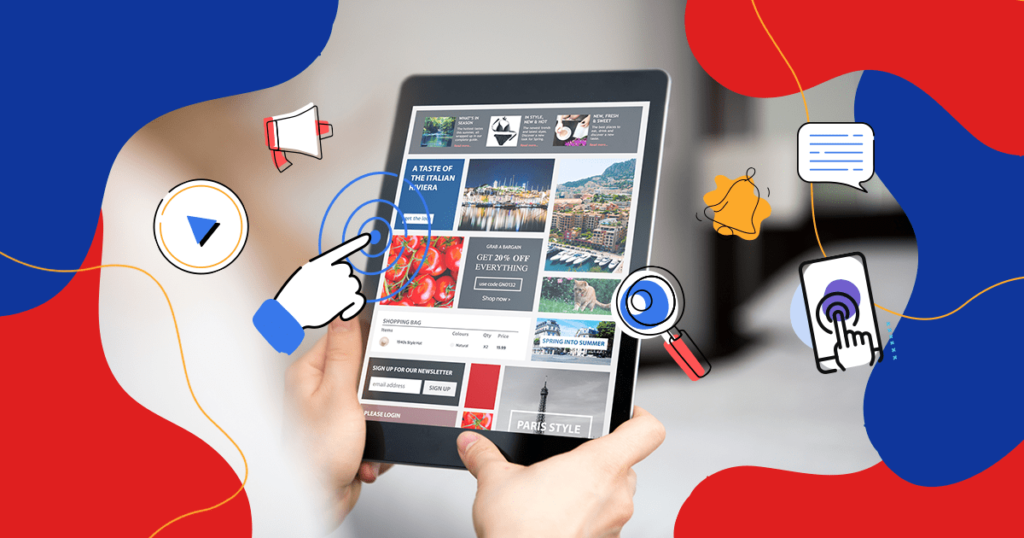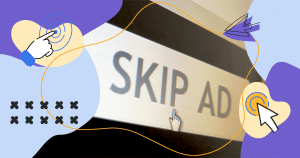It’s 2023 and to this day users with disabilities have difficulty accessing blogs, websites, and various other materials. There is a clear pattern of unintentional exclusion where marketing materials don’t cater to differently-abled people.
Only 3% of websites are accessible to users with disabilities. The number of accessible B2B websites is even smaller.
And, with these sites featuring unique interactive tools, like content-gating forms and long-form blogs, the need to achieve web accessibility is pressing.
In this blog, we’ll help you bridge the gap by explaining what website accessibility is, how to achieve it, and how it can help B2B businesses expand their reach to critically under-served parts of the market.
- What is web accessibility and why is it important?
- The disabled community’s buying power
- How to create an accessible website
- Accessibility is an ongoing commitment
What is web accessibility and why is it important?
Web accessibility standards and best practices ensure that people with disabilities can participate in web-based experiences.
That includes navigating a website, downloading an ebook, watching a webinar, and more.
There is no one-size-fits-all approach to accessibility. There are many types of disability, and each one can have a wide range of impacts on different people.
However, website owners can address these impacts in a standardized way.
The Web Content Accessibility Guidelines (WCAG for short) establish best practices for addressing the needs of web users with disabilities.
Following these guidelines doesn’t guarantee that every person with a disability will be able to use your website. However, they provide a common starting point that allows website owners to make their web experiences more inclusive.
WCAG is also core to compliance with the Americans with Disabilities Act (ADA for short).
In most cases, websites that are WCAG-compliant are also ADA-compliant.
Following WCAG protocols is the best way to ensure ADA compliance.
Not every website is designed with compliance in mind. In fact, very few are.
That’s why B2B website owners use a WCAG compliance checker to find out how they improve web accessibility. This will help you find out what stands between you and achieving WCAG compliance. You’ll be provided with a detailed report, highlighting the areas of your website that need to be tweaked to achieve optimal web accessibility status.
The disabled community’s buying power
While accessibility is important from a moral perspective, it is also a valuable brand differentiator.
About 15% of the global population experiences some form of disability. Disabilities are not limited by national or cultural barriers. They impact every demographic, everywhere on the planet.
That means that your customer audience is made up, in part, by people with disabilities. The Kessler Foundation reports that people with disabilities form an increasing proportion of the American workforce. The year-over-year trend continues to pick up steam with consistent percentage-point gains.
Ignoring these people is not only unjust but unwise.
If your B2B marketing strategy relies on driving organic traffic to your blog, it doesn’t make sense to exclude around 15% of your potential customers.
Yet this is exactly what many businesses do.
For people with disabilities, web accessibility is absolutely vital to the user experience.
Many of these people find non-compliant websites impossible to use. They are met with content, like everyone else, but are completely excluded from interacting with it.
That content plays a crucial role in the B2B buyer’s journey.
Making your site accessible opens it up to an entirely new audience of people who have already likely been excluded by your non-accessible competitors.
It’s the right thing to do, and it’s a profitable business strategy as well.
How to create an accessible website
The official WCAG 2.1 document contains more than 100 pages of highly technical web design and interactivity standards. It’s an intimidating document with many rules, clauses, and stipulations.
But, you don’t need to become an expert on accessibility to build an accessible website.
Many of the WCAG 2.1 protocols revolve around a core set of principles that are easy to understand.
Implement these in your website and you will be well on your way to accessibility compliance:
Allow for keyboard navigation
A mouse is a wonderful tool, but it isn’t very accessible. The same is true of touchpads and touchscreen displays. People with visual or motor skill disabilities can’t use these devices.
Instead, many people with disabilities use specialty keyboards.
Devices like these can turn almost any kind of physical input – like Stephen Hawking’s cheek twitch – into a keyboard command.
Similarly, screen-reading software like JAWS work entirely off keyboard commands. If your website has a button or feature that isn’t keyboard-accessible, screen-reader users won’t be able to use it.
Allowing people to navigate your website and consume content only using keyboard commands is one of the best ways to improve site-wide accessibility.
This is especially important for B2B websites that use interactive content (e.g. on-video forms) to capture and convert leads.
Leverage heading hierarchies
Headings are especially important for screen reader users.
These solutions group text content together based on the web page’s heading structure. That allows users with visual disabilities to skim through content without having to read every single word on the page.
They can’t do this if your web pages fail to use proper HTML headings.
Usually, this happens when content writers divide blocks of normal text with additional normal text. The dividing text may be enlarged or bolded, but it isn’t a heading. Screen readers will read that text the same way as everything else on the page.
Headings are part of the structure of your web page. They’re tagged in a specific hierarchy of importance, usually from H1 to H4. All rich text editors allow content writers to separate blocks of text using these headings. Make sure your website does the same.
Add descriptive alt-text
Image files present a problem for screen reader users. When a screen reader encounters an image file, it will read the image’s alt-text tag to the user. If there is no alt-text, the software will simply say “image” aloud, and then move on.
Adding alt-text to images allows screen reader users to understand contextual clues they may otherwise miss. If the image in question has important information on it, then the alt-text tag is the only place screen readers can obtain that information.
This is especially important for images that support written content. Charts, infographics, and other explanatory images have a vital role to play in B2B content marketing. Alt-text tags ensure that people with visual disabilities can understand those images properly.
The more descriptive an alt-text tag is, the better.
Try to encapsulate the value of the image and show why it was chosen in the first place.
Perfect the art of color contrasts
Bad color contrast can have an enormous impact on both usability and accessibility. Even people with perfect vision can’t easily read text written over a similarly colored background. Accessible website text must be set against a background that offers decent color contrast.
For most websites, color contrast isn’t a difficult issue in body text. It’s a much more common issue for banners, header text, and page titles. That’s because this text often lays over an image. If the color of the text and the image are too similar, it will be unreadable.
Rock Content’s homepage is a great example of color contrast at work. It has a light purple flare background behind the main image and black text on top. It’s simple, effective, and easy to read.
There are a few things you can do to fix color contrast on your website:
Adjusting text color to have a 4.5:1 contrast ratio is one of the easiest solutions.
Many accessible websites layer a transparent box between background images and header text. Others simply move the header text next to the image, rather than on top of it.
Make sure videos are accessible
Video marketing is a core component of any modern B2B marketing strategy. If you want to showcase a product or demonstrate a new technology, video is the most immersive format you can choose.
However, video can also be one of the most challenging formats for users with disabilities. It combines audio and visual information to tell a story, and most video players have a point-and-click interface.
Captions and transcripts play a vital role in enabling people with disabilities to enjoy video content. Captions are ideal for people who are hard of hearing, while transcripts enable screen reader users to follow along as well.
Ensuring keyboard navigability for video content can be difficult. Not all video hosting providers offer an accessible user experience. Posting transcripts may allow you to bypass this requirement, but it will not always perfectly convey the meaning of video content well.
The same is true of forms.
If you gate video content with a form, you have to make sure it’s accessible and easy to fill out. It should be clearly legible, navigable by keyboard, and screen-reader compatible.
Optimize compliance with powerful 3rd party solutions
WCAG protocols contain an enormous number of technical design details. These include specific color contrast ratios, operability standards, anchor link performance, and more.
Manually verifying all of these is a difficult and time-consuming process. You would need to memorize, check, and cross-reference hundreds of minor technical details on every page of your website.
Web accessibility tools can help you automate this task. Tools such as accessWidget incorporate AI to automatically fix inaccessible code within your site.
It also enables website visitors with disabilities to modify your website’s UI based on their individual needs. This includes adjusting color and display options, enabling keyboard navigation, and adjusting for screen reader technology.
Be aware that not every requirement in the WCAG standard can be automated. Some of these requirements refer to the way content conveys “meaning” to users. Only a human being can verify that.
Accessibility is an ongoing commitment
Accessibility is more than a compliance box to be checked. There is no way to guarantee that every person, with every disability, will find your website and all of its content accessible. Part of the accessibility journey involves taking feedback from people with disabilities and implementing it.
The sooner you start that journey, the better the outcome will be. Take time to audit your website and identify areas where you can improve content accessibility. Reach out to the disability community and show it that you are invested in its success and integration. It will respond in kind.
For more guidelines on how to market your business to various audiences, check out our marketing planning bundle.









